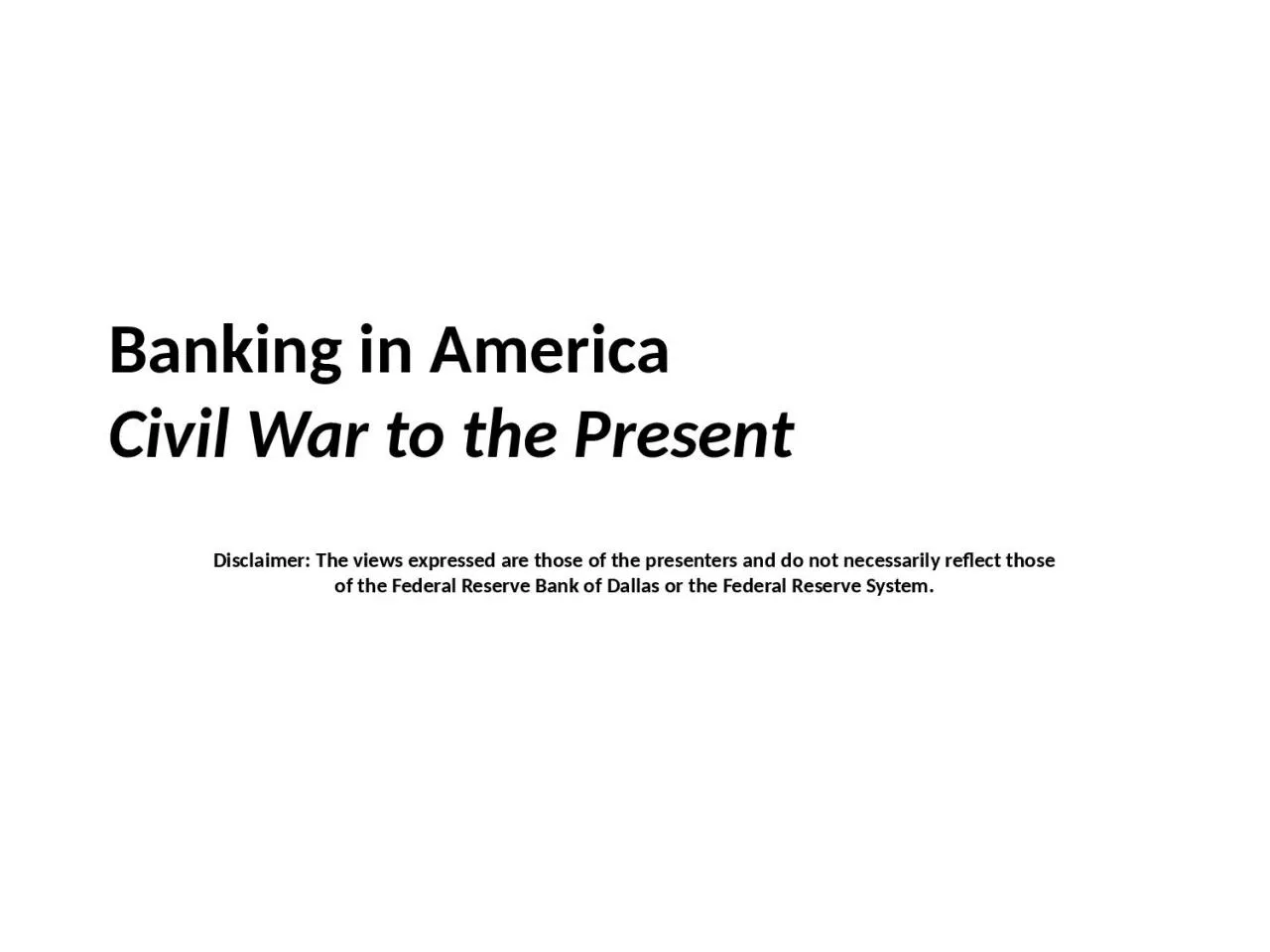

Disclaimer The views expressed are those of the presenters and do not necessarily reflect those of the Federal Reserve Bank of Dallas or the Federal Reserve System The End of the State Banking Era ID: 1027303
Download Presentation The PPT/PDF document "Banking in America Civil War to the Pres..." is the property of its rightful owner. Permission is granted to download and print the materials on this web site for personal, non-commercial use only, and to display it on your personal computer provided you do not modify the materials and that you retain all copyright notices contained in the materials. By downloading content from our website, you accept the terms of this agreement.
1. Banking in AmericaCivil War to the PresentDisclaimer: The views expressed are those of the presenters and do not necessarily reflect those of the Federal Reserve Bank of Dallas or the Federal Reserve System.
2. The End of the State Banking Era
3. Legal Tender Note
4. National Bank ActCreated a uniform currencyNotes from different regions no longer discountedCreated federally chartered banks with uniform standardsRequired to hold U.S. bonds as capitalMandated supervision and examinations by Office of Comptroller of the Currency
5. National Currency
6. State Banks AttackedAlmost 1,600 in 1860, only 350 in 186510% tax placed on state bank notes – upheld by Supreme Court Chief Justice Salmon P. ChaseState banks introduce demand depositsDual banking system still exists today!
7. Panic of 1873Triggered by the collapse of Jay Cooke and Co.largest bank in the U.S.Agent for Northern Pacific Railroad bondsCooke’s bank could not sell enough railroad bonds to cover obligationsLed to a sell-off in the stock marketRuns on other large financial institutions led to their failure
8. Panic of 1893Sparked by failure of Philadelphia and Reading RailroadWithdrawal of European investment led to a crisis in railroad financeStock market crash and a banking panic followedCreated a run on the U.S. gold supply
9. Panic of 1907Knickerbocker Trust Company failed leading to runs on other trust companiesWidespread panicBank failuresShrinking money supplyDeep recessionJ.P. Morgan, along with other bankers, served as lender of last resort and quelled the panic
10. The Role of a Central BankIssue and maintain the value of currencySupervise banksServe as the fiscal agent for the governmentConduct monetary policyServe as a lender of last resort
11. The Federal Reserve Act of 1913“ to provide for the establishment of Federal reserve banks, to furnishing elastic currency, to afford means of rediscounting commercial paper, to establish a more effective supervision of banking in the United States, and for other purposes.”
12. The Federal Reserve Today
13. Structure of the Fed
14. Board of Governors Ben Bernanke ChairmanDaniel K. Tarullo
15. Federal Reserve Banks
16. Federal Open Market Committee FOMC
17. Three ResponsibilitiesSupervise and Regulate BanksProvide Financial ServicesConduct Monetary Policy
18. Supervise and Regulate BanksBoard of Governors writes the rules that regulate financial institutions.Reserve Banks supervise banks and enforce the rules during bank examinations.
19. Goals of Banking Supervision and Regulation
20. Financial ServicesCash servicesElectronic paymentsCheck processing
21. Financial Services for the U.S. TreasuryBanking servicesIssuing, transferring and redeeming U.S. government securities
22. Economic Goals
23. Achieving Economic Goals
24. Tools of Monetary Policy
25. The Great Depression
26. Why is the “Great Depression” significant?Worst economic crisis of the 20th centuryCauses and cures still debatedDefining event in American historyChanged public’s expectations of the governments’ role in the economy
27. Stock Market Crash of 1929
28. Stock market crash of 1929What was the role of the stock market crash?Destroyed wealthReduced trust in the health of the financial systemEconomic uncertainty (constrained spending)Probably had some effect, but not big enough by itself to cause depression.
29. Three Schools of ThoughtKeynesian explanationMonetarist explanationInternational explanation
30. John Maynard Keynes (1883—1946)British economistPrincipal representative for the British Treasury at Versailles – anticipated burden of reparation debt on GermanyRepresented U.K. at Bretton Woods Conference after WWII
31. Keynesian ExplanationKeynes advocated government spending to break this cycle.
32. Monetarist explanationShrinking supply of money and credit deepened and lengthened the Great DepressionLandmark book in 1963, A Monetary History of the United States, by Milton Friedman and Anna Schwartz
33. Monetarist Explanation
34. Where was the Fed?Failed to serve as lender of last resortPrevailing thought that failing banks should be allowed to failMany failed banks were small, nonmember banksFew banks borrowed at the discount windowRaised interest rates in support of the gold standard
35. International explanationNations around the world experienced a downturnProtectionist “beggar-thy-neighbor” tariffs Smoot-Hawley tariff in the U.S.International gold standard
36. The Collapse of World Trade$ value imports of 75 countries
37. Smoot-Hawley TariffsIncreased the cost of imported goodsRetaliatory measures from trading partners –which dried up foreign markets left products with nowhere to go.Trade collapsed world wide – not just an American phenomena
38. Gold StandardInternational system of fixed exchange ratesDomestic impact of global standard through gold as reserves in the bank systemFederal Reserve supported the gold standard
39. Supporting the Gold StandardAllow gold to flow out of the country → bank lending is constrainedRaise interest rates → attract international investment and gold How do these affect bank lending and consumer and business spending?
40. Since the Great DepressionTreasury-Fed Accords (1951)Humphrey-Hawkins Act (1977)
41. Questions?